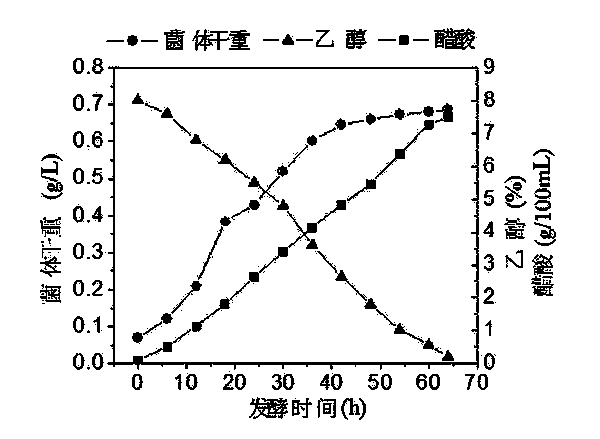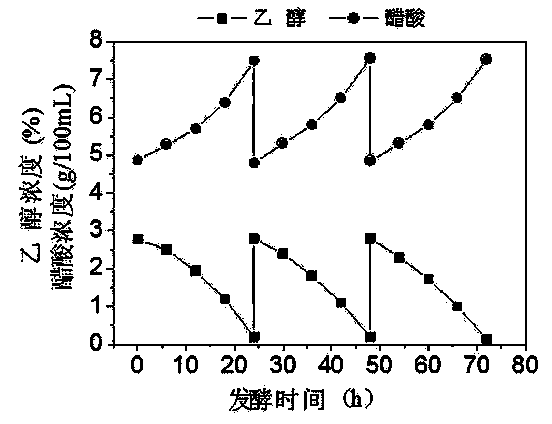High-temperature-resistant acetic acid bacteria and application thereof in production of acetic acid through fermentation
A technology of acetic acid bacteria and acetic acid, which is applied in the direction of fermentation, microorganism-based methods, bacteria, etc., can solve the problems of not meeting the requirements of industrial production, low acid production rate and raw material utilization rate, and improve production efficiency and raw material utilization rate. Reduced fermentation cooling costs and high ethanol conversion
- Summary
- Abstract
- Description
- Claims
- Application Information
AI Technical Summary
Problems solved by technology
Method used
Image
Examples
Embodiment 1
[0033] Example 1 Obtaining High-temperature-resistant Acetic Acid Fermentation Strains
[0034] (1) Microbial enrichment culture
[0035] Take 1-3 g samples of vinegar fermented grains from the 3rd to 6th day of acetic fermentation of Shanxi mature vinegar. The sampling position is 15 cm away from the surface of vinegar fermented grains. The rotation speed was 180 rpm, and the enrichment culture was carried out at 42°C for 36 hours.
[0036] Enrichment medium composition: glucose 20 g / L, yeast extract 15 g / L, ethanol 4% (v / v), acetic acid 5 g / L.
[0037] (2) Continuous high temperature and high concentration ethanol acclimatization culture
[0038] Transfer the fermented liquid obtained in the above step (1) to a 10% (v / v) inoculum into a shaker flask filled with 100 mL of acclimatization medium. After 36 hours, they were transferred to fresh acclimatization medium.
[0039] The composition of acclimatization medium is: glucose 20 g / L, yeast extract 15 g / L, ethanol 7%-12% ...
Embodiment 2
[0044] Example 2 Comparison of Acetic Fermentation Properties of Acetobacter pasteurii CGMCC No. 8189 and Acetobacter AS1.41
[0045] (1) Preparation of seed solution
[0046] Acetobacter pasteuriani CGMCC No. 8189 and Acetobacter AS1.41 were inoculated from the slant into the seed medium, and cultured on a shaker at 37 °C and 160 rpm for 24 hours, at 10% (v / v) The inoculum was transferred into fresh seed medium for scale-up cultivation.
[0047] Seed medium composition: glucose 20 g / L, yeast extract 15 g / L, ethanol 3.5% (v / v).
[0048] (2) Acetic fermentation
[0049] According to the inoculum amount of 10% (v / v), the seed solutions of Acetobacter pasteurii CGMCC No. 8189 and Acetobacter AS1.41 obtained in (1) were respectively inoculated into fermenters for acetic fermentation. During the fermentation process, the fermentation temperature was controlled at 37 °C, and the ventilation rate was 1:0.1 (v / v) / min.
[0050] The composition of the fermentation medium was: gluc...
Embodiment 3
[0054] Example 3 Batch Fermentation of Acetic Acid Using Acetobacter pasteurianus CGMCC No. 8189
[0055] (1) Preparation of seed solution
[0056] Acetobacter pasteurianus CGMCC No. 8189 was inoculated from the slant into the seed medium, and cultured on a shaker at 37°C and 160 rpm for 25 hours. According to the 10% (v / v) inoculum size, transfer to fresh seed medium for scale-up culture.
[0057] Seed medium composition: glucose 20 g / L, yeast extract 15 g / L, ethanol 3.5% (v / v).
[0058] (2) Acetic fermentation
[0059] According to the inoculum amount of 12% (v / v), inoculate the seed liquid obtained in (1) into a fermenter for acetic acid fermentation.
[0060] The composition of the fermentation medium was: glucose 30 g / L, yeast extract 20 g / L, ethanol 8% (v / v), acetic acid 3 g / L, MgSO 4 0.1 g / L, CaCl 2 0.2 g / L.
[0061] During the fermentation process, the fermentation temperature is controlled as: 33°C in the early stage (for 20 hours), 37°C in the middle stage ...
PUM
 Login to View More
Login to View More Abstract
Description
Claims
Application Information
 Login to View More
Login to View More - R&D
- Intellectual Property
- Life Sciences
- Materials
- Tech Scout
- Unparalleled Data Quality
- Higher Quality Content
- 60% Fewer Hallucinations
Browse by: Latest US Patents, China's latest patents, Technical Efficacy Thesaurus, Application Domain, Technology Topic, Popular Technical Reports.
© 2025 PatSnap. All rights reserved.Legal|Privacy policy|Modern Slavery Act Transparency Statement|Sitemap|About US| Contact US: help@patsnap.com



